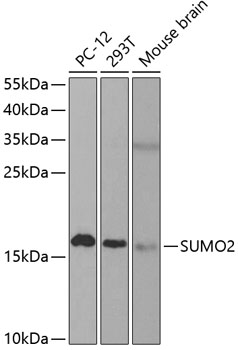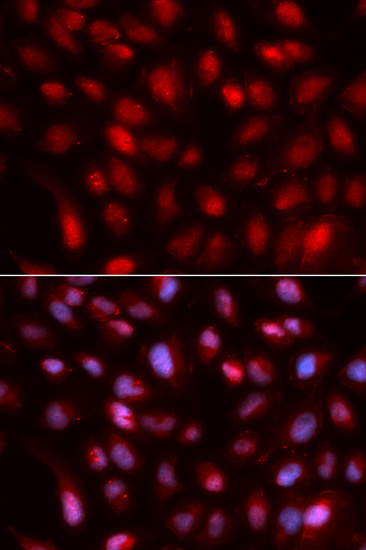Signal Transduction Antibodies 2
Anti-SUMO2 Antibody (CAB2571)
- SKU:
- CAB2571
- Product Type:
- Antibody
- Reactivity:
- Human
- Reactivity:
- Mouse
- Reactivity:
- Rat
- Host Species:
- Rabbit
- Isotype:
- IgG
- Research Area:
- Signal Transduction
Description
| Antibody Name: | Anti-SUMO2 Antibody |
| Antibody SKU: | CAB2571 |
| Antibody Size: | 20uL, 50uL, 100uL |
| Application: | WB IF |
| Reactivity: | Human, Mouse, Rat |
| Host Species: | Rabbit |
| Immunogen: | Recombinant fusion protein containing a sequence corresponding to amino acids 1-95 of human SUMO2 (NP_008868.3). |
| Application: | WB IF |
| Recommended Dilution: | WB 1:500 - 1:2000 IF 1:50 - 1:200 |
| Reactivity: | Human, Mouse, Rat |
| Positive Samples: | PC-12, 293T, Mouse brain |
| Immunogen: | Recombinant fusion protein containing a sequence corresponding to amino acids 1-95 of human SUMO2 (NP_008868.3). |
| Purification Method: | Affinity purification |
| Storage Buffer: | Store at -20'C. Avoid freeze / thaw cycles. Buffer: PBS with 0.02% sodium azide, 50% glycerol, pH7.3. |
| Isotype: | IgG |
| Sequence: | MADE KPKE GVKT ENND HINL KVAG QDGS VVQF KIKR HTPL SKLM KAYC ERQG LSMR QIRF RFDG QPIN ETDT PAQL EMED EDTI DVFQ QQTG GVY |
| Gene ID: | 6613 |
| Uniprot: | P61956 |
| Cellular Location: | Nucleus, PML body |
| Calculated MW: | 8kDa/10kDa |
| Observed MW: | 17kDa |
| Synonyms: | SUMO2, HSMT3, SMT3B, SMT3H2, SUMO3, Smt3A |
| Background: | This gene encodes a protein that is a member of the SUMO (small ubiquitin-like modifier) protein family. It functions in a manner similar to ubiquitin in that it is bound to target proteins as part of a post-translational modification system. However, unlike ubiquitin which targets proteins for degradation, this protein is involved in a variety of cellular processes, such as nuclear transport, transcriptional regulation, apoptosis, and protein stability. It is not active until the last two amino acids of the carboxy-terminus have been cleaved off. Numerous pseudogenes have been reported for this gene. Alternate transcriptional splice variants, encoding different isoforms, have been characterized. |
| UniProt Protein Function: | SUMO2: Ubiquitin-like protein that can be covalently attached to proteins as a monomer or as a lysine-linked polymer. Covalent attachment via an isopeptide bond to its substrates requires prior activation by the E1 complex SAE1-SAE2 and linkage to the E2 enzyme UBE2I, and can be promoted by an E3 ligase such as PIAS1-4, RANBP2 or CBX4. This post-translational modification on lysine residues of proteins plays a crucial role in a number of cellular processes such as nuclear transport, DNA replication and repair, mitosis and signal transduction. Polymeric SUMO2 chains are also susceptible to polyubiquitination which functions as a signal for proteasomal degradation of modified proteins. Homotrimer (Potential). Crystal packing analysis suggests a possible trimeric assembly, of which the biological significance remains to be determined. Interacts with SAE2 and UBE2I. Covalently attached to a number of proteins. Interacts with PELP1. Interacts with USP25; the interaction sumoylates USP25. Broadly expressed. Belongs to the ubiquitin family. SUMO subfamily. 2 isoforms of the human protein are produced by alternative splicing. |
| UniProt Protein Details: | Protein type:Ubiquitin-like modifier Chromosomal Location of Human Ortholog: 17q25.1 Cellular Component: nucleoplasm; PML body; nucleus Molecular Function:protein binding; ubiquitin protein ligase binding Biological Process: protein sumoylation; cellular protein metabolic process; positive regulation of proteasomal ubiquitin-dependent protein catabolic process; post-translational protein modification |
| NCBI Summary: | This gene encodes a protein that is a member of the SUMO (small ubiquitin-like modifier) protein family. It functions in a manner similar to ubiquitin in that it is bound to target proteins as part of a post-translational modification system. However, unlike ubiquitin which targets proteins for degradation, this protein is involved in a variety of cellular processes, such as nuclear transport, transcriptional regulation, apoptosis, and protein stability. It is not active until the last two amino acids of the carboxy-terminus have been cleaved off. Numerous pseudogenes have been reported for this gene. Alternate transcriptional splice variants, encoding different isoforms, have been characterized. [provided by RefSeq, Jul 2008] |
| UniProt Code: | P61956 |
| NCBI GenInfo Identifier: | 378405233 |
| NCBI Gene ID: | 6613 |
| NCBI Accession: | P61956.3 |
| UniProt Secondary Accession: | P61956,P55855, Q32Q42, Q6IPZ6, Q96HK1, B2R4I2, |
| UniProt Related Accession: | P61956 |
| Molecular Weight: | 95 |
| NCBI Full Name: | Small ubiquitin-related modifier 2 |
| NCBI Synonym Full Names: | small ubiquitin-like modifier 2 |
| NCBI Official Symbol: | SUMO2 |
| NCBI Official Synonym Symbols: | HSMT3; SMT3B; SUMO3; Smt3A; SMT3H2 |
| NCBI Protein Information: | small ubiquitin-related modifier 2; sentrin 2; SMT3 homolog 2; ubiquitin-like protein SMT3A; ubiquitin-like protein SMT3B; SMT3 suppressor of mif two 3 homolog 2 |
| UniProt Protein Name: | Small ubiquitin-related modifier 2 |
| UniProt Synonym Protein Names: | HSMT3; SMT3 homolog 2; SUMO-3; Sentrin-2; Ubiquitin-like protein SMT3B |
| Protein Family: | Small ubiquitin-related modifier |
| UniProt Gene Name: | SUMO2 |
| UniProt Entry Name: | SUMO2_HUMAN |
View AllClose







![SUMO2/3 Monoclonal Antibody [PAT10F1AT] (CPAB0433) SUMO2/3 Monoclonal Antibody [PAT10F1AT] (CPAB0433)](https://cdn11.bigcommerce.com/s-rd6ounxcu2/images/stencil/590x590/products/58655/63837/sumo23-monoclonal-antibody-pat10f1at-cpab0433__03919__88132.1706535173.jpg?c=1)
